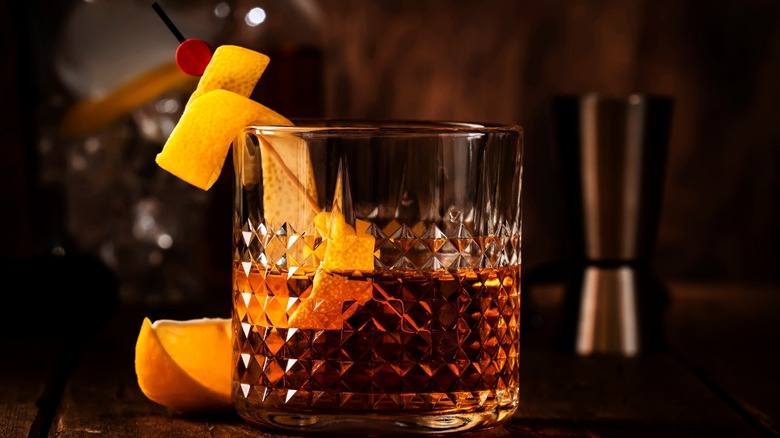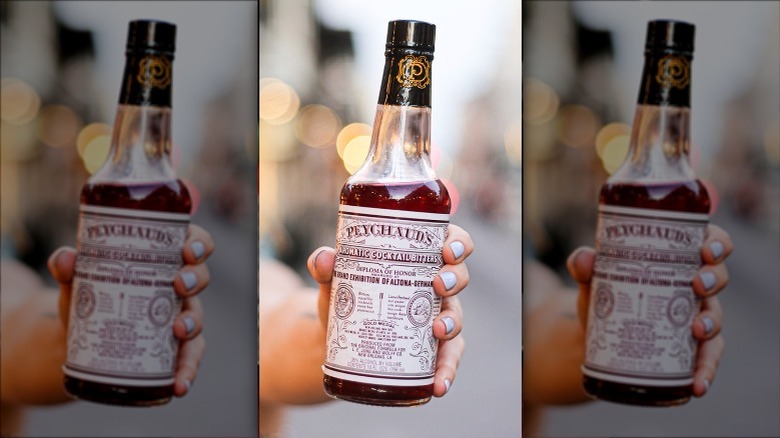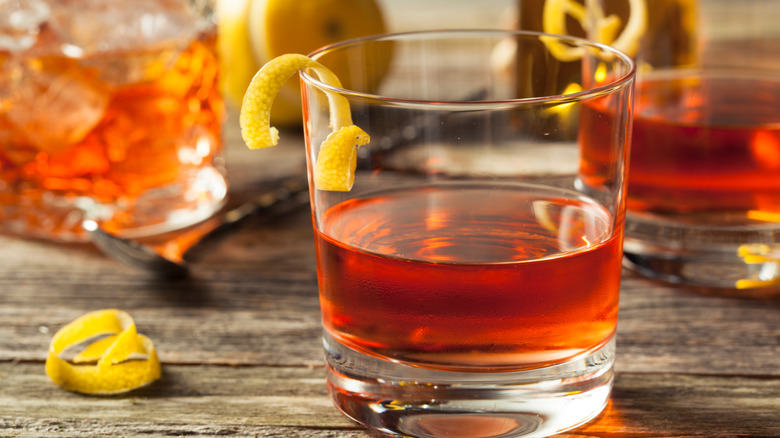The First Cocktail Ever Created Is Still Around In Full Force
Few menu items can fancify a function like a good, old-fashioned cocktail. People have been unsurprisingly mixing alcohol for centuries, but the modern cocktail was born out of the inadvertent discovery that the floral fruity notes of medicinal bitters actually pair quite nicely with liquor. In the 1700s, the British created proto-cocktails when they combined bitters with Canary wine, and were also enjoying alcoholic punch bowls that included liquor, spices, and fruit juices, providing a blueprint for the cocktails we know and love today.
The first use of the word "cocktail" to definitively describe an alcoholic beverage was in an 1806 edition of the American newspaper The Balance and Columbian Repository, which described the concoction as "A stimulating liquor composed of spirits of any kind—sugar, water, and bitters."
The true origin of the cocktail is still up for debate, with evidence that points towards both London and New York as two potential founding sites. However, it's the city of New Orleans that claims to be the birthplace of the world's first true cocktail, the Sazerac. The potent mixture of rye whiskey, Peychaud's bitters, and Hersaint (similar to absinthe), all brought together with a little sugar, is one of the most stylistically classic cocktails you can enjoy and is still a celebrated drink to this day.
The origins of Sazerac
The evolution of the Sazerac began with Antoine Amédée Peychaud, a Haitian-born apothecary who migrated to New Orleans sometime during the Haitian Revolution. Peychaud opened up his own drug store around the end of the 1830s (the exact year is up for debate), where he sold his own bitters to an eager client base. He also mixed his signature product with brandy in an egg-shaped cup called coquetier, a name that is often falsely attributed to the etymology of the word cocktail.
Peychaud's Bitters still remains an essential part of the Sazerac recipe, but it wasn't until a merchant named Sewel Taylor introduced a French brandy, Sazerac-de-Forge et Fils, to New Orleans that the modern cocktail started to take shape. Taylor worked as a bartender at the Merchants Exchange coffee house before he eventually bought a lease to run the business in 1845. Taylor's imported cognac became the hottest menu item. The next owner of the business, Aaron Bird, combined the popular spirit with the bitters he bought from Peychaud down the street and reportedly changed the bar's name to the Sazerac Coffee House.
The sazerac quickly became a favorite drink in New Orleans. Then disaster struck. Towards the end of the 19th century, a phylloxera infestation in Europe destroyed France's vineyards and the cognac base for the cocktail was no longer available. So bartenders in New Orleans started using locally available rye, rounding out the recipe as we know it today.
The legacy of the NOLA cocktail
New Orleans' love affair with the Sazerac never ended. Considering the cocktail's intimate history with the Big Easy, it's a wonder that it took until 2008 for the Louisiana House of Representatives to name the Sazerac the official cocktail of New Orleans. The Sazerac House itself lives on in a company that has become one of America's largest spirits distributors, while there is also now a museum near the original historic site detailing the lineage of the beverage and letting visitors explore the cocktail history of the city.
If you're in New Orleans, the main spot to nurse a Sazerac today is at the aptly named Sazerac Bar at the Roosevelt Hotel. Of course, nowadays the recipe is a common staple of cocktail bars across the country. And some even let patrons choose between rye or cognac.
A pharmacist named J.G. Legendre added the absinthe-like Herbsaint liqueur to the recipe in 1934 (eventually the Sazerac company bought the brand from Legendre, making the new recipe official), but since then it hasn't changed much. There does exist a New York-based creation called the Zazarack that substitutes rye for bourbon, while modern mixologists have added complementary flavors like banana and pumpkin. Still, the aromatic, slightly minty, licorice-like blend of anise flavoring and deep, spicy rye remains a profoundly respected NOLA tradition.



